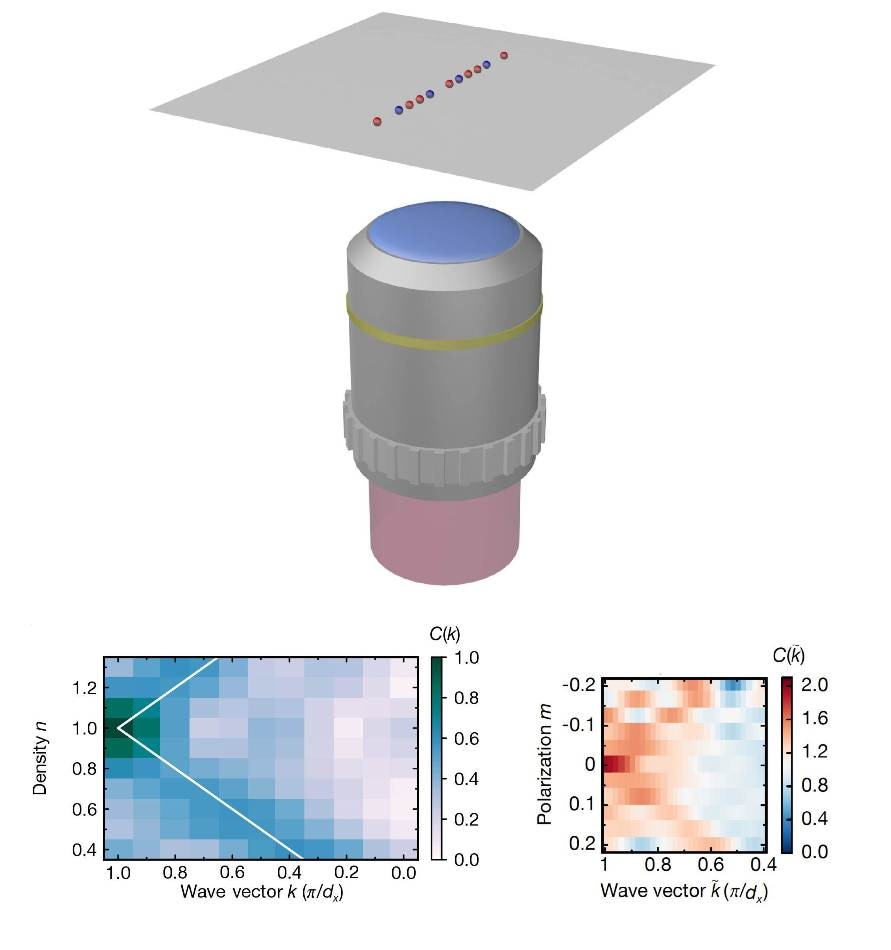Dec 14 2018
Guillaume Salomon, a postdoc at the Max Planck Institute of Quantum Optics and a group of researchers have been successful in directly observing a basic effect of 1D quantum systems. They achieved this by investigating ultracold atoms trapped in artificial crystals of light.
 Quantum gas microscopy of Hubbard chains reveals incommensurate spin correlations. Top: Synthetic Fermi-Hubbard chains are realized by trapping a spin mixture of lithium-6 atoms in optical lattices (red and blue spheres denote up and down spins). Imaging the system with single-particle and single-spin resolution using a quantum gas microscope allows one to study individually the effects of doping and spin polarization on spin correlations. Bottom: The Fourier transforms of the spin correlations reveal the change in periodicity of the magnetic correlations with density and polarization, in excellent agreement with the predictions of the Luttinger liquid theory. (Image credit: Guillaume Salomon/MPQ)
Quantum gas microscopy of Hubbard chains reveals incommensurate spin correlations. Top: Synthetic Fermi-Hubbard chains are realized by trapping a spin mixture of lithium-6 atoms in optical lattices (red and blue spheres denote up and down spins). Imaging the system with single-particle and single-spin resolution using a quantum gas microscope allows one to study individually the effects of doping and spin polarization on spin correlations. Bottom: The Fourier transforms of the spin correlations reveal the change in periodicity of the magnetic correlations with density and polarization, in excellent agreement with the predictions of the Luttinger liquid theory. (Image credit: Guillaume Salomon/MPQ)
The team noticed a stretching of the magnetic ordering while diluting the atoms in the lattice by detecting one by one.
The research was performed this year in the Division headed by Immanuel Bloch, a director at the Max Planck Institute of Quantum Optics and professor at the Ludwig Maximilians University in Munich. The new discovery is relevant, for instance, in relation to high-temperature superconductors with the ability to achieve lossless conduction of electricity.
One crucial problem related to high-temperature superconductivity is to understand the interplay between magnetism and doping, from which exotic electronic phases can emerge. However, our knowledge is highly dependent on the dimensionality of the system, and quantum gas experiments can help to bridge the gap between one and two dimensions.
Guillaume Salomon, Postdoc, Max Planck Institute of Quantum Optics.
Salomon has been involved in studies in this field since 2014.
In this study, the researchers at the Max Planck Institute of Quantum Optics collaborated with scientists from the physics departments of the Ludwig Maximilians University and the University of Trento to trap a cloud of lithium-6 atoms at 7 nanokelvin in a light crystal to achieve a clean and well-controlled Fermi-Hubbard model.
The Fermi-Hubbard model is the most fundamental model for electronic systems where interactions have a vital role to play (i.e. strongly correlated systems). It represents spin-up or spin-down atoms in a lattice that repulsively interact only when they are positioned in the same site. On average, if there is one atom on each site, antiferromagnetic ordering happens at places where spins on adjacent sites are anti-aligned.
Upon diluting the system, the number of atoms in the lattice decreases (doped) and the periodicity of this magnetic ordering varies analogous to an accordion that gets stretched. Rather than finding opposite spins on adjacent sites, they can be found to be anti-aligned at larger distances on average. Then, the spin correlations are regarded to be incommensurate. It is also anticipated that such an effect would occur when the numbers of up and down spins vary (spin polarization).
The researchers employed a method known as spin-resolved quantum gas microscopy, which enables both the spins and positions of all the atoms to be imaged simultaneously, and allows measurement of spin correlations. They noticed the advent of such incommensurate spin correlations, which were discovered to differ linearly with doping and polarization, in exceptional agreement with theoretical predictions.
The most fascinating part of this research project has been the disentanglement of the effects of spin-polarization and doping on spin correlations in one dimension where spin-charge separation occurs. The ability to measure all the spins and particle positions in a strongly correlated quantum many-body system allows us to compute arbitrary correlation functions akin to numerical studies on a computer and to quantitatively test fundamental predictions despite the finite temperature of our systems.
Guillaume Salomon, Postdoc, Max Planck Institute of Quantum Optics.
“At the end of this study, we observed in the doped Fermi-Hubbard model fundamental differences between one dimension and two dimensions. Our results are an important benchmark for further studies of the dimensional crossover regime, about which very little is known until now,” added Christian Gross, who led the research team.